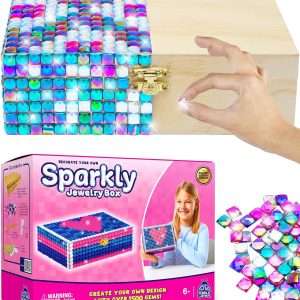The Timeless Allure of Jewelry: A Journey Through History and Style
Jewelry has captured hearts and imaginations for centuries. From the intricate designs of ancient civilizations to the sleek lines of modern-day pieces, each era brings its flair and significance. For young girls aged 8-12, jewelry not only serves as a beautiful accessory but also becomes a cherished part of their identity Jewelry Box For Girls 8-12 Yrs Old. A well-crafted jewelry box for girls in this age group can hold many treasures that spark joy and creativity.
Join us on a journey through time as we explore how jewelry transcends mere adornment to become a symbol of culture, expression, and personal style. Discover the timeless allure behind these gems while uncovering what makes them resonate deeply with all generations—especially those just beginning to find their sparkle!
Ancient Jewelry: From Talismans to Adornments
Ancient jewelry was more than just decoration; it served various profound purposes. In early civilizations, pieces were often crafted from bone, shell, and metals. These items acted as talismans or amulets believed to offer protection or bring good fortune.
As time progressed, jewelry evolved into a form of personal expression. Ancient Egyptians adorned themselves with gold and precious stones that reflected their status and spirituality. Necklaces featuring hieroglyphs told stories, while bracelets were inscribed with powerful symbols.
In Mesopotamia, intricate designs emerged, showcasing the artistry of cultures long past. Jewelry became a bridge between the earthly realm and divine connections. Each piece carried meaning—whether for love, power, or remembrance—creating lasting legacies that still captivate us today.
These ancient adornments laid the foundation for how we perceive jewelry in modern times: not merely as accessories but as vessels of history and emotion.
Middle Ages and Renaissance: Symbolism and Opulence
During the Middle Ages, jewelry became a powerful symbol of status and wealth. Noble families adorned themselves with intricate pieces that reflected their lineage. Goldsmiths crafted unique designs filled with gemstones, each carrying its meaning.
Religious symbols were prominent during this period. Crosses and saints’ medallions offered spiritual protection while showcasing artistry. Gemstones like sapphires and emeralds were believed to hold magical properties, making them even more desirable.
As the Renaissance emerged, opulence reached new heights. Jewelry transformed into wearable art, capturing the essence of humanism and individuality. The introduction of techniques like enamel added vibrant colors to these luxurious pieces.
This era celebrated beauty, intellect, and creativity through jewelry design. It was a time when adornments spoke volumes about personal identity and social standing in an ever-evolving world.
The Rise of Diamonds in the Modern Era
Diamonds have transcended their role as mere gemstones, becoming symbols of enduring love and commitment. The late 19th century marked a significant turning point when diamond mines in South Africa were discovered. Suddenly, these sparkling stones became more accessible to the masses.
Marketing campaigns, particularly those by influential companies like De Beers, shaped public perception. Their slogan, “A Diamond is Forever,” solidified diamonds as an essential part of engagement traditions.
As society evolved through the decades, so did people’s tastes. Diamonds began appearing not just in rings but also in necklaces and earrings. This versatility made them appealing for various occasions.
Today’s consumers seek authenticity alongside luxury. Lab-grown diamonds offer eco-friendly alternatives without sacrificing brilliance or beauty. This shift reflects a broader movement toward ethical consumption while maintaining that timeless allure associated with traditional diamonds.
Art Nouveau and Art Deco Movements: Breaking the Traditional Mold
Art Nouveau emerged in the late 19th century, embracing organic forms and flowing lines. This artistic style drew inspiration from nature, celebrating beauty in asymmetry. Jewelry became an extension of this philosophy, featuring intricate designs with floral motifs and curved shapes.
Art Deco burst onto the scene as we transitioned into the Roaring Twenties. It was bold and glamorous, a stark contrast to its predecessor. Clean lines and geometric patterns defined this era. Diamonds took center stage alongside vibrant gemstones like emeralds and sapphires.
Both movements broke away from traditional jewelry norms. They encouraged self-expression through innovative craftsmanship, and the daring styles resonated with individuals seeking uniqueness during times of social change.
These eras paved the way for future designers to explore new materials and techniques while emphasizing personal identity through adornment. Today’s pieces often echo these revolutionary ideas, reminding us of their lasting impact on jewelry design.
Contemporary Jewelry Trends: Minimalism, Sustainability, and Personalization
Contemporary jewelry trends reflect a deep connection to individuality and conscious living. Minimalism reigns supreme, embracing simplicity in design. Clean lines and subtle forms make statements without overwhelming the wearer.
Sustainability is another significant trend shaping today’s jewelry landscape. Eco-friendly materials and ethically sourced gems are now top priorities for many artisans. This shift resonates with consumers who value environmental responsibility as much as style.
Personalization adds a unique touch that speaks volumes about identity. Custom pieces allow individuals to express their stories or commemorate special moments. Whether through initials, birthstones, or meaningful symbols, personalized jewelry connects deeply with its owners.
Fusing these elements creates a vibrant tapestry of modern adornments, appealing to diverse tastes while honoring values that matter in today’s society.
The Power of Jewelry: How It Makes Us Feel and What It Says About Us
Jewelry holds a unique power. It transcends mere decoration, becoming an extension of our identity and emotions. For many, wearing jewelry evokes feelings of confidence and self-expression. A simple necklace or earrings can elevate an outfit and transform our perception.
The stories behind each piece add to their significance. Whether passed down through generations or crafted as a personal memento, jewelry often carries memories that resonate deeply within us. It reflects who we are at any given moment—our style, mood, and even our aspirations.
The allure of jewelry is particularly enchanting for young girls aged 8-12. As they begin to explore their individuality, having their own “jewelry box for girls 8-12 years old” opens up countless possibilities for creativity and exploration. Each piece becomes more than just an ornament; it expresses personality.
Moreover, jewelry often serves as a form of communication without words. A bold statement ring conveys confidence in one’s choices, while delicate bracelets symbolize friendship or love shared with others. In this way, adornments become part of our narrative—a visual language articulating what resides within us.
Whether it’s cherished heirlooms or trendy pieces from contemporary collections, beauty lies in aesthetics and connection—connection to history, culture, emotion… and, most importantly, to ourselves.


